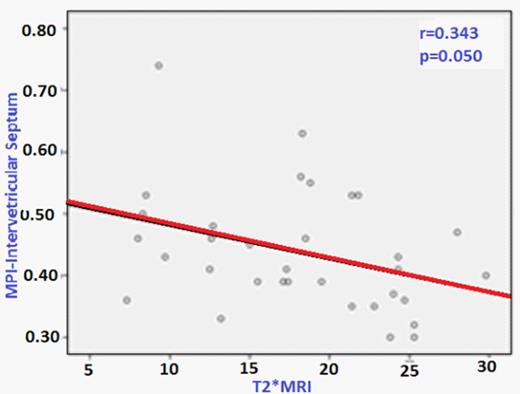Abstract
Introduction: Early detection of myocardial dysfunction and modification of treatment may prevent from progressing into the end stage heart failure and lethal arrhythmias in beta-thalassemia major (β-TM). T2* magnetic resonance imaging (MRI), a non-invasive technic determining iron accumulation in myocardium has been widespreadly used in these patients. Cardiac T2* MRI is not capable to evaluate cardiac functions but, indicates patients with risk for developing cardiac disease. Therefore, combining T2*MRI with tissue Doppler (TD) echocardiography, another technic defining both functional and structural evaluation of myocardium, could give a better information in evaluating the actual status of myocardium.
The aim of this study was to evaluate cardiac status of thalassemics by using both T2*MRI and TD measurement.
Methods: The study group includedpatientswith β-TM on regular transfusion and chelation program with preserved systolic function; ejection fraction > 55% and fractional shortening > 30% determined by conventional echocardiography. None of them had other organ dysfunctions adversely effecting cardiac functions. The control group was consisted of age and sex matched healthy persons. Serum ferritin levels were measured in both groups. In addition, TD measurements (S,E,A waves, time intervals; ejection time, total systolic time, isovolumetric accelaration time, isovolumetric contraction time, isovolumetric relaxation time and myocardial performance index) were obtained from three different regions of myocardium; septum, left and right ventricular posterior walls. T2* MRI was only determined in thalassemics.
The study group was divided into two different subgroups according to serum ferritin level (low ferritin < 2500 ng/ml and high ferritin > 2500 ng/ml) and T2* MRI score (iron overloaded <20 ms and unloaded >20ms). The results obtained by TD within these subgroups were compared. TD measurements in thalassemics without cardiac iron overload were separately compared with the controls.
Results: The study and control groups were consisted of 33 β-TM patients (16 girls/17 boys, mean age 18,7±7,7 years) and 37 healthy individuals (18 girls/19 boys, age 19,9±8,4 years), in respectively. Gender and age were similar (p>0,05). Systolic and diastolic functions by TD were found significantly impaired in thalassemics compared to the controls (p<0,05). S-lateral wave measurement showing early myocardial systolic function was more adversely effected in thalassemics (p<0,001). The patients' mean ferritin level was found 2242,3±2174,2 ng/ml (109-9843). Twelve patients (36,4%; 12/33) had high ferritin level and the rest (63,6%; 21/33) had low. T2*MRI and TD measurements did not differ in both subgroups (p>0.05). The mean T2*MRI score was 18,7±7,7 (7,3-29,8) ms in the study group. Twenty-one patients (63,6%; 21/33) had myocardial iron overload. Serum ferritin levels were similar between iron overloaded and unloaded groups (p>0.05). Both isovolumetric acceleration time of left ventricule and myocardial performance index (MPI-septal) showing systolic and diastolic functions were found significantly impaired in iron overloaded subgroup (p<0,05). There was negative correlation between MPI-septal and T2*MRI measurements in thalassemics (r:-0,343, p=0,050, fig 1).
When we compared the velocity measurements (S,E,A waves) of iron unloaded thalassemics with the controls; only S wave velocity obtained from left ventricular wall was found significantly low (p<0,05). The time intervals measured from septum were found similar with the controls (p>0,05) but, the same measurements obtained from left and right ventricular posterior walls were significantly impaired (p<0,05).
Conclusions: This study showed that thalassemics with iron overload had significantly impaired TD measurements and MPI-septal index worsened when the mycardial iron load was increased (fig 1). Patients considered as iron unloaded according to T2*MRI result had left and right ventricular dysfunction determined by TD. Normal cardiac T2*MRI does not always associated with normal cardiac function. Therefore, we conclude that combining T2*MRI with TD measurements in evaluating cardiac status in β-TM, especially in patients with normal T2*MRI score, could lead to a better management of cardiac complications.
No relevant conflicts of interest to declare.
Author notes
Asterisk with author names denotes non-ASH members.


This feature is available to Subscribers Only
Sign In or Create an Account Close Modal